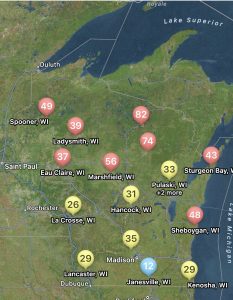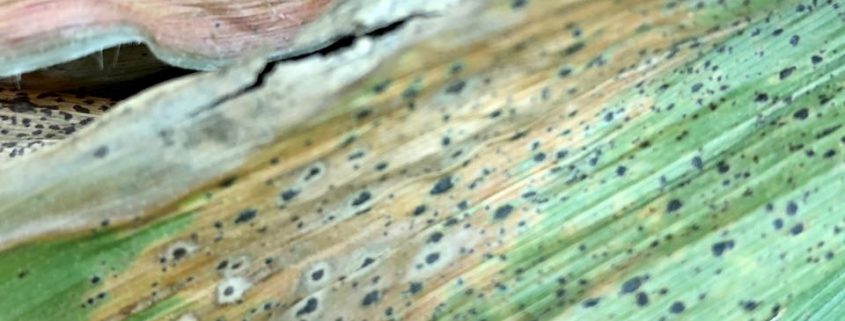Wisconsin Field Crops Disease Update, August 9, 2023
Damon Smith, Extension Field Crops Pathologist, Department of Plant Pathology, University of Wisconsin-Madison

Figure 1. A Screen shot of a map developed in the Field Prophet app showing risk for tar spot development in Wisconsin as of August 9, 2023.
Well, it was going to happen sometime soon, tar spot has been confirmed in two counties in Wisconsin. You can track tar spot confirmations in realtime HERE. Both Lafayette and Rock counties were confirmed to have low levels of tar spot in several fields this week. The good news is that these finds are a month behind the initial confirmations in the state for the last two seasons. What does this mean? Well, it means that the tar spot impact on grain yield will likely not be has significant as it has been over the last couple of seasons. Exceptions to this statement will include late-planted corn where the current growth stages are around VT (tasseling) and susceptible silage hybrids. You should scout and track these situations carefully. Be prepared to chop silage early if tar spot really starts to move. You will want to watch moisture carefully in these situations.
The current risk for tar spot development remains moderate to high across much of the state (Fig. 1). Cooler weather and dewy evenings and mornings are keeping the risk elevated. Fungicide applications for much of the corn in the state should have happened already. Remember the optimal time to apply fungicides to control tar spot (and most other foliar corn diseases) is between the VT (tasseling) and R3 (milk) growth stages. Spraying fungicide after R3 has not yielded much of a return on investment. If you find tar spot, please don’t hesitate to send a high-quality photo to damon.smith@wisc.edu. We don’t disclose exact locations, but do like to track the county-level tar spot information. If you would like to learn more about tar spot and managing it, see my previous post HERE.

Figure 2. Sporecaster predictions for selected non-irrigated locations in Wisconsin for August 9, 2023.
In other news, white mold risk ranges from low in the southern portion of the state to moderate and high in the mid and upper portions of the state, respectively (Fig. 2). Most soybeans are probably headed toward the R4 or R5 growth stage. This means fungicide applications will no longer yield positive returns on investment. If soybeans were planted late and they are still in the R1 to R3 growth stages and you are in a moderate to high risk area, a fungicide should be applied at this time. If you would like to learn more about white mold management, see my previous post HERE. We have observed active white mold on susceptible varieties under irrigation already this season. I am anticipating pockets of white mold in the state, especially in our typical areas of concern in the central and northeastern quadrants.
As always, make sure you are out and scouting to be prepared for what is coming ahead!





